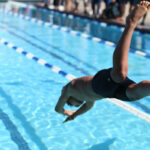When I first started swimming, I thought swim goggles were all the same. I grabbed a cheap pair, slapped them on, and jumped in the pool. Two laps later, I was squinting through foggy lenses, frustrated because I couldn’t see a thing. On top of that, the goggles dug into my face, leaving red marks and letting in water by the end of my swim. It was a mess!
If you’re looking to avoid the mistakes I made, this guide will help you find goggles that fit well, stay clear, and make swimming way more enjoyable.

What Are the Different Types of Swim Goggles?
Not all goggles are built the same. The right pair depends on where and how you swim.
Recreational Goggles
These are the go-to for casual swimmers. They’re usually soft and comfy, making them great for a quick splash or an occasional swim. However, they’re not super durable, so don’t expect them to last through heavy use.
Training Goggles
If you’re in the water a lot, whether you’re practicing laps or working on endurance, training goggles are your best bet. They’re designed to be comfortable and long-lasting. These are my personal favorites because they’re reliable for regular use.
Racing Goggles
For competitive swimmers, racing goggles are sleek and tight. They reduce drag, which helps you go faster, but they’re not exactly cozy. I tried them once, and let’s just say my face was ready for a break after 30 minutes.
Open Water Goggles
If you’re braving the great outdoors, whether it’s a lake, ocean, or river, these goggles have larger lenses for a better field of view. They also protect your eyes from the sun and reflections on the water.

What Features Should You Look For?
Once you know the type of goggles you need, it’s time to focus on the features that make or break your swimming experience.
1. Lens Type and Color
The lenses aren’t just for seeing underwater, they can change how everything looks.
- Clear Lenses: Perfect for indoor pools or cloudy days.
- Tinted Lenses: Great for outdoor swimming when the sun’s out.
- Mirrored Lenses: These reduce glare on bright days. They’re my go-to for outdoor swims.
- Polarized Lenses: A lifesaver for open water, cutting down on harsh sunlight bouncing off the waves.
2. Anti-Fog Coating
Ah, foggy lenses, the ultimate frustration. My first goggles didn’t have any anti-fog treatment, and I had to keep stopping to rinse them. Look for goggles with an anti-fog coating. If they start fogging after a while, a quick fix is using anti-fog spray or even a dab of baby shampoo before rinsing.
3. Comfort
Nobody wants goggles that pinch their face or leave painful red marks. Look for soft silicone gaskets around the lenses, and make sure you can adjust the straps and nose bridge. I learned the hard way that comfort matters just as much as a good seal.
4. Durability
If you’re swimming often, you want goggles that can handle wear and tear. Scratched lenses or broken straps are a no-go. Spending a little more on a quality pair can save you from constantly replacing them.
5. Field of Vision
Wide lenses let you see more without turning your head, which is especially useful in open water. For pool swimming, a narrower field of vision works fine, as long as you can see the lane lines clearly.

How to Test Goggles Before You Buy Them
Finding the perfect pair isn’t just about reading labels, it’s about trying them on.
- Press Them On: Without using the straps, press the goggles onto your eyes. If they stay on for a few seconds without falling, they have a good seal.
- Adjust the Straps: Make sure they’re easy to tighten or loosen.
- Move Your Head: Look up, down, and side to side. The goggles shouldn’t shift or press too hard.
How to Keep Your Goggles in Great Shape
Once you’ve found a pair that works, you’ll want to keep them in good condition:
- Rinse After Use: Chlorine and saltwater can damage goggles. Give them a quick rinse with clean water.
- Don’t Touch the Lenses: It’s tempting to rub them clean, but this can scratch the lenses and ruin the anti-fog coating.
- Use a Case: Storing your goggles in a case keeps them safe from scratches and dirt.
What’s It Like to Use Cheap Goggles?
When I first started swimming, I thought, “Why spend more on goggles when I can get these cheap ones?” Well, I found out why pretty quickly. The lenses fogged up almost immediately, the straps felt flimsy, and water kept sneaking in. After a few frustrating weeks, I switched to a better pair, and the difference was night and day.

Do Goggles Need to Be Replaced?
Even the best goggles won’t last forever. Over time, the anti-fog coating wears off, straps lose their elasticity, and seals might start to leak. My rule? If I’m spending more time adjusting my goggles than swimming, it’s time for a new pair.
Final Thoughts
Picking the right goggles might take a little trial and error, but trust me, it’s worth it. A good pair can make your swim sessions smoother, clearer, and way more enjoyable. Take your time, try a few options, and find the ones that fit you best.
Have you ever struggled to find the perfect goggles? Share your story, I’d love to hear it!




